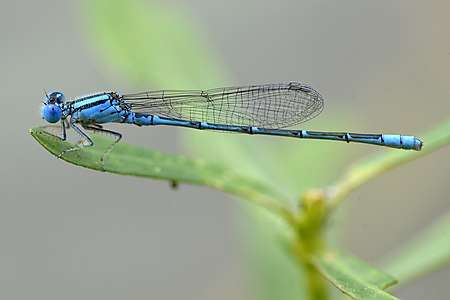Paracercion malayanum
Paracercion malayanum,[2][1] Malay lillysquatter,[3][4] is a species of damselfly in the family Coenagrionidae. It is known to occur in India, Sri Lanka, Nepal, Java, Philippines and Thailand.[1]
| Malay lillysquatter | |
|---|---|
 | |
| Paracercion malayanum, male | |
| Scientific classification | |
| Kingdom: | |
| Phylum: | |
| Class: | |
| Order: | |
| Suborder: | |
| Family: | |
| Genus: | |
| Species: | P. malayanum |
| Binomial name | |
| Paracercion malayanum (Selys, 1876) | |
| Synonyms | |
| |
Description and habitat
It is a medium sized damselfly with deep blue eyes. Its thorax is black on dorsum with very broad azure blue antehumeral stripes, which are very narrow or missing in Paracercion calamorum. Lateral sides of thorax are blue with a fine black line on the upper part of each lateral suture. No pruinescence compared to P. calamorum. Its wings are transparent and pterostigma is yellow, framed with heavy black nervures. Its abdomen is azure blue with broad black dorsal marks up to segment 7. Segment 2 has a distinct broad dorsal spot shaped like a thistle-head connected narrowly to a fine apical ring. This mark will help to distinguish it from Pseudagrion species. Segment 10 has a narrow mid-dorsal black streak. Female is dull green in colors. Its abdomen is similar to the male. But the lateral ground colour is yellowish red and segments 8 and 9 are broadly black on dorsum. Segment 10 is blue only in the apical border.[5]
It breeds in shallow lakes, ponds and paddy fields in the lowland, perches on the floating vegetation.[5][6][3][4]
See also
- List of odonates of India
- List of odonata of Kerala
References
- Dow, R.A. (2009). "Cercion malayanum". IUCN Red List of Threatened Species. 2009: e.T163753A5646293. doi:10.2305/IUCN.UK.2009-2.RLTS.T163753A5646293.en.
- Martin Schorr; Dennis Paulson. "World Odonata List". University of Puget Sound. Retrieved 12 Oct 2018.
- "Paracercion malayanum Selys, 1876". India Biodiversity Portal. Retrieved 2017-03-03.
- "Paracercion malayanum Selys, 1876". Odonata of India, v. 1.00. Indian Foundation for Butterflies. Retrieved 2017-03-03.
- C FC Lt. Fraser (1933). The Fauna of British India, including Ceylon and Burma, Odonata Vol. I. Red Lion Court, Fleet Street, London: Taylor and Francis. pp. 375-376.
- Subramanian, K. A. (2005). Dragonflies and Damselflies of Peninsular India - A Field Guide.
External links
![]()
![]()
